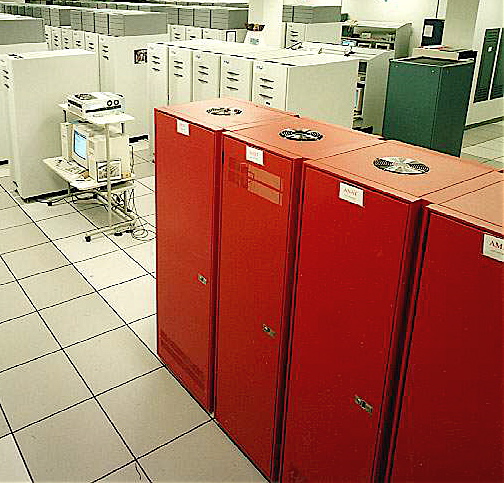
Every office has them. Back rooms with stacks of keyboards, rows of 15-inch monitors, piles of desktop CPUs, and miles of cables, just for starters. That’s fine for PCs, but what do you do with over-the-hill supercomputers?
That’s the question that Sandia National Labs faces, as it prepares to put ASCI Red, at one time the world’s first teraflop supercomputer, out to pasture.
“I’ve never buried a computer before,” said Justin Rattner, Intel Chief Technology Officer.
Sandia director Bill Camp said that ASCI Red had the best reliability of any supercomputer ever built, and “was supercomputing’s high-water mark in longevity, price, and performance.”
“It was almost mystical in scalability,” said another Sandia director, Rob Leland. “All these other machines would be tailing off and Red would still be cruising along.”
Sandia researcher Michael Hannah emphasized that the machine was not being decommissioned because of technical problems. “It’s not a reliability issue, because ASCI Red is still reliable,” he said. “It is about getting more bang for the buck with nine-year-newer technology and terminating significant costs in space, power, and cooling.”
I wonder if they have garage sales at Sandia Labs?















Sounds like it would be useful for beta-testing Vista!
I don’t think it meets the minimum requirements.
Just like older PC’s can be used for less demanding work that do not demand bleeding edge architecture I suspect that ASCI Red could be allowed to matriculate down to a less demanding user. But I know the feeling, I just gave away some very expensive analog recording gear, top of the line in it’s day, simply because I didn’t have the heart to toss it.
I live in Albuquerque. Maybe they can give it to UNM or something. IIRC it’s a Linux machine running as a Beowulf cluster.
That old computer logic of lesser task is flat out wrong. The reason:
Power….
Sure you could pick up an array of… say 500 8086 PC XT machines and make’em do the job of a … what… pentium 3 800mhz? what would they do? run linux and do a real cool firewall? consuming what? 200Watts times 500… 10 kilowats…sheesh.
After a while the cost/benefit of a system is flat out throwing money out the door….
Cray’s XT3 uses AMD64 Opterons and can scale up to 30,000 processors with a blade design.
Ya, and it’s too big for a door stop.
meh, how about a supercompter aquarium? or kegarator?
Funny to catch myself looking at the picture and thinking it is just a few cabinets… “…those four Red ones, right?”
Then follow the link to the picture of the “artist’s concept”, and the table of facts… i.e. total number of cabinets = 104. System footprint = ~2500 sq ft.
http://www.sandia.gov/ASCI/Red/
Picture a hi-res version of “Fish” that runs real-time HD video with the path of every bubble and mote programmed.
A concept artist could build something even more impressive with it, I’ll bet. Maybe Samsung would give them a 102-inch Plasma.
Maybe someone could use it to update their website?
>*This page is available without frames*
I guess I’ll mention the funniest — at least absurd — part of putting up this post. ASCI Red has always had it’s own website. I went there to pull a photo from their gallery to use for this post — and discovered they’ve pulled all the photos from the site. I don’t know when.
The image above — is from Russia.
I went there to pull a photo from their gallery to use for this post — and discovered they’ve pulled all the photos from the site.
I was wondering why there was only an “artists’ concept” when I looked.
they should just list in the FREE section of Craigslist….it would be gone in a day.